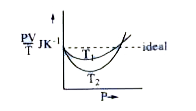(A): Specific heat is defined as the amount of heat required to raise the temperatrue of unit mass of the substance through unit degree.
(R): A gas has unique value of specific heatSolution in Telugu
Both (A) and ( R) are true and (R ) is the correct explanation of (A)
Both (A) and (R ) are true and (R ) is not the correct explanation of (A)
(A) is true but (R ) is false
Both (A) and (R ) are false
The correct Answer is:C
Step by step video, text & image solution for (A): Specific heat is defined as the amount of heat required to raise the temperatrue of unit mass of the substance through unit degree. (R): A gas has unique value of specific heat by Physics experts to help you in doubts & scoring excellent marks in Class 11 exams.
Topper's Solved these Questions
- BOOK - AAKASH SERIESCHAPTER - KINETIC THEORY OF GASESEXERCISE - EXERCISE-2(Kinetic Theory of an ideal gas)25videos
KINETIC THEORY OF GASES
- BOOK - AAKASH SERIESCHAPTER - KINETIC THEORY OF GASESEXERCISE - EXERCISE-3(Kinetic Theory of an ideal gas)4videos
KINETIC THEORY OF GASES
- BOOK - AAKASH SERIESCHAPTER - KINETIC THEORY OF GASESEXERCISE - EXERCISE-IA(Degree of Freedom)35videos
KINETIC THEORY OF GASES
- BOOK - AAKASH SERIESCHAPTER - KINEMATICSEXERCISE - ADDITIONAL PRACTICE EXERCISE (PRACTICE SHEET (ADVANCED)) (Integer Type Questions)12videos
KINEMATICS
- BOOK - AAKASH SERIESCHAPTER - LAWS OF MOTIONEXERCISE - PRACTICE EXERCISE108videos
LAWS OF MOTION
Similar Questions
cylinder of capacity 20 litres is filled with H2 gas. The total average kinetic energy of translatory motion of its molecules is 1.5×105 J. The pressure of hydrogen in the cylinder is
07:25View SolutionGiven is the graph between PV/T and P for 1 gm of oxygen gas at two different temperature T1 and T2 (Given:Density of oxygen=1.429kg/m3).The value of PV/T at the point A and the relation between T1 and T2 and respectively
 03:23View Solution
03:23View SolutionA cylinder rolls without slipping down an inclined plane, the number of degrees of freedom it has, is
02:03View SolutionThree particles start from origin at the same time: one with velocity v1 along positive x - axis, the second along the positive y-axis with a velocity v2 and the third along the line y=x with such a speed that all the three always stay in a straight line, then the velocity of the third particle is √kV1V2(V1+V2).
03:17View SolutionA force of 50 N acts on a body of mass 10 kg at rest. Its velocity after 5 seconds if the same force acts, is
04:24View SolutionAmout of heat required to raise the temperature of unit mass of the substance through unit degree is called……..of the substance.
03:01View SolutionAssertion: Specific heat of a body is always greater than its thermal capacity.
Reason: Thermal capacity is the heat required for raising temperature of unit mass of the body through unit degree07:25View SolutionStatement 1: A gas has a unique value of specific heat.
Statement 2: Specific heat is defined as the amount of heat required to raise the temperature of unit mass of the substance through unit degree.01:16View SolutionThe amount of heat absorbed by a body while raising its temperature is given by the equation. Q = mstheta , here Q is the amount of heat, m is the mass of the body, s is the specific heat capacity and theta is the rise tmemperature. Dertermine the S.I. unit and C.G.S. unit of heat and specific heat capacity
02:12View SolutionDefine specific heat capacity .
01:55View SolutionDefine heat capacity and specific heat capacity. Give their S.I. units.
01:14View SolutionThe quantity of heat required to raise the temperature fo a unit mass of a substance through one degree celsius called ____
03:18View SolutionSpecific heat is defined as the heat required to raise the temperature of 1 kg substance through 1 K. The unit of specific heat in S.I is
02:14View SolutionAssertion : A gas have a unique value of specific heat. Reason : Specific heat is defined as the amount of heat required to raise the temperature of unit mass of the substance through unit degree.
03:10View SolutionDefine specific heat of a substance
01:57View Solution
